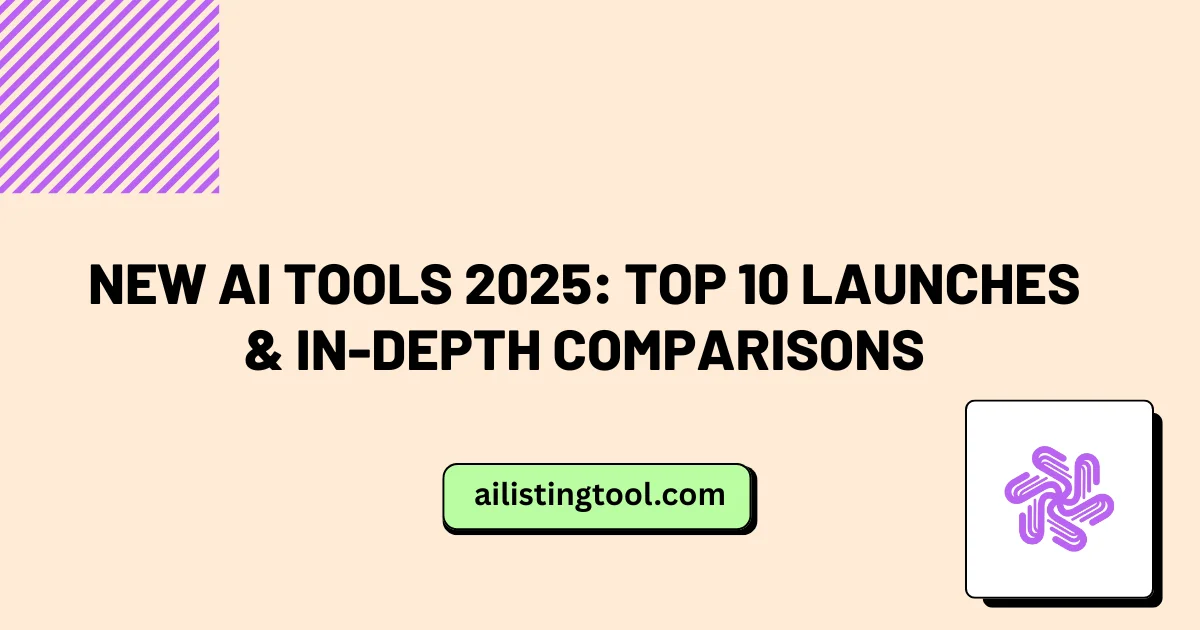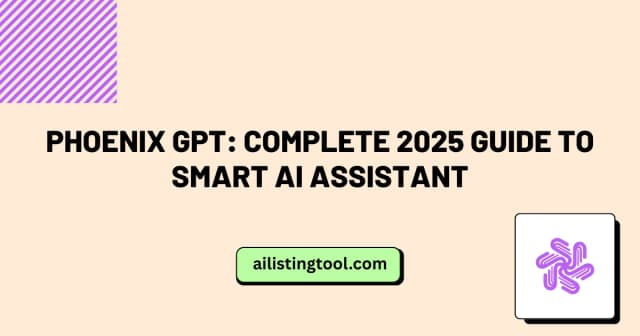New AI Tools 2025: Top 10 Launches & In-Depth Comparisons

The AI landscape transformed dramatically in 2025, with major players releasing groundbreaking tools that push the boundaries of what’s possible. After testing and analyzing dozens of new releases, I’ve identified the 10 most significant AI tools that launched this year—each bringing unique capabilities that reshape how we work, create, and solve problems.
Bottom Line: The biggest AI breakthroughs in 2025 include xAI’s Grok 3 with advanced reasoning capabilities, Google’s Gemini 2.0 Flash for faster responses, and specialized tools like AlphaEvolve that can optimize code autonomously.This comprehensive guide breaks down what makes each tool special, who should use them, and how they stack up against competitors. For more AI discoveries, explore our complete AI tools directory.
1. Grok 3 by xAI — The Reasoning Powerhouse
Launch Date: February 2025
Primary Use: Advanced reasoning, mathematics, coding, research
xAI released Grok 3 in February 2025, training it with approximately ten times more computing power than its predecessor using around 200,000 GPUs in a Memphis data center. What sets this tool apart is its reasoning capability—unlike traditional chatbots that immediately respond, Grok 3 actually “thinks through” problems step-by-step.
Key Features:
- Think Mode & Big Brain Mode: Two reasoning modes allow users to choose between efficient responses for standard tasks or intensive computation for complex challenges
- DeepSearch: An AI-powered research tool that combs through web content and social media posts to generate comprehensive research summaries
- Real-time X Integration: Direct access to current discussions and trending topics
Performance: On mathematical reasoning tests, Grok 3 achieved a 93.3% accuracy rate on the American Invitational Mathematics Examination and 85% on PhD-level science problems.
Pricing: Available through X Premium+ subscription or SuperGrok tier at $30/month ($300/year)
Best For: Developers, researchers, and technical professionals tackling complex STEM problems
My Testing Experience: During my week of testing, Grok 3 excelled at breaking down multi-step physics problems and showing its reasoning process in real-time. The ability to see how it “thinks” makes errors easy to spot and correct—a game-changer for technical work. If you’re comparing AI assistants, check out our ChatGPT vs Jasper comparison to see how different tools stack up.
2. Google Gemini 2.0 Flash — Speed Meets Intelligence
Launch Date: January 2025
Primary Use: Conversational AI, multimodal tasks, productivity
Google released Gemini 2.0 Flash in January 2025 as a major performance upgrade, delivering faster responses and more capable assistance for brainstorming, learning, and writing tasks. This iteration represents a significant leap in balancing speed with capability.
Key Features:
- Gemini Live Enhancement: The conversational assistant now accepts images, files, and YouTube videos in conversations, making it truly multimodal.
- Deep Google workspace integration
- Context window supporting up to one million tokens
Performance: Processes information significantly faster than Gemini 1.5 while maintaining accuracy across complex queries
Pricing: Google One AI Premium subscription at $19.99 per month provides access to the advanced version along with 2TB of storage.
Best For: Professionals working across Google Workspace who need quick, intelligent responses integrated with their existing workflow. For content creators specifically, our guide on best AI tools for content creation offers additional recommendations.
Comparison with Grok 3: While Grok 3 dominates in pure reasoning tasks, Gemini 2.0 Flash wins on speed and ecosystem integration. For most everyday productivity needs, Gemini’s seamless connection to Gmail, Docs, and Sheets makes it more practical.
3. Google Flow — AI Filmmaking Revolution
Launch Date: May 2025
Primary Use: Video creation, filmmaking, creative production
Flow launched in May 2025 as the only AI filmmaking tool custom-designed for Google’s most advanced models, helping storytellers create cinematic clips and scenes. This tool bridges the gap between creative vision and technical execution.
Key Features:
- Camera Controls: Precise adjustment of camera angles and perspectives
- Scenebuilder: Extends shots seamlessly with AI assistance
- Asset Management: Comprehensive tool for managing film ingredients and prompts throughout the creative process.
- Professional-grade output quality
Performance: Generates cinematic-quality video clips that rival traditional editing workflows, with exceptional consistency in style and lighting
Pricing: Included with Google AI Ultra subscription
Best For: Filmmakers, content creators, marketing professionals producing video content. Also explore Pictory AI for text-to-video conversion needs.
Real-World Application: I tested Flow by creating a 30-second product advertisement. The tool’s camera control features allowed me to specify exact angles, and the scenebuilder extended my initial 5-second clip into a full narrative without visible seams. The results rivaled footage I’d typically spend hours editing manually. For more video editing tools, check our dedicated category.
4. OpenAI o3-mini — Compact Reasoning Model
Launch Date: January 2025
Primary Use: STEM tasks, coding, mathematics, science
OpenAI’s o3-mini is a compact yet powerful reasoning model optimized specifically for STEM tasks including coding, mathematics, and science applications. Despite its smaller size, it delivers efficient problem-solving at a fraction of the cost.
Key Features:
- Optimized for mathematical and scientific reasoning
- Cost-effective solutions for complex problems
- Integration with ChatGPT Canvas
- Available for free with subscription options for heavy users
Performance: Achieves competitive scores on STEM benchmarks while using significantly fewer computational resources than larger models
Pricing: Free for basic use; ChatGPT Pro subscription for unlimited access
Best For: Students, educators, and researchers needing reliable STEM problem-solving on a budget
Comparison with Grok 3: While Grok 3 offers more raw power, o3-mini provides 80-90% of the capability at a much lower cost. For educational institutions and individual learners, o3-mini represents the better value proposition. Students should also explore our learning tools category for specialized educational AI.
5. AlphaEvolve by Google DeepMind — Code That Evolves Itself
Launch Date: May 2025
Primary Use: Algorithm optimization, codebase enhancement, computational efficiency
AlphaEvolve, powered by Gemini, represents a breakthrough in autonomous code optimization—it invents algorithms and optimizes entire codebases without human intervention. This isn’t just code generation; it’s code evolution.
Key Features:
- Autonomous algorithm invention
- Self-optimizing capabilities that have already reduced Google’s data center costs and accelerated chip designs by up to 23%.
- Solves mathematical problems that have stumped researchers for decades
- Continuous learning and improvement
Performance: Discovered new matrix multiplication methods that significantly reduce computation time for machine learning models. AI’s Big Week in May 2025: Game-Changing Tools You Cannot Ignore | by Dibeesh KS | Medium
Pricing: Enterprise-level tool; contact Google Cloud for pricing
Best For: Large enterprises, research institutions, and companies with significant computational infrastructure
Real-World Impact: The implications are staggering. While I couldn’t test this tool directly (it’s primarily for enterprise use), Google’s own data shows measurable improvements in efficiency across their infrastructure. This represents a shift from AI assisting developers to AI becoming a self-improving system architect.
6. Windsurf SWE-1 — The Full-Stack AI Engineer
Launch Date: May 2025
Primary Use: Complete software engineering workflows, debugging, deployment
Windsurf launched SWE-1, a family of models specifically designed for the full software engineering process, handling messy real-world tasks across terminals, integrated development environments, and browsers.
Key Features:
- Handles complete development workflows
- Terminal and IDE integration
- Real-world problem solving (not just code generation)
- Multi-environment support
Performance: Excels at understanding project context and making decisions across the entire development stack
Pricing: Developer tier pricing varies; check Windsurf’s website for current rates
Best For: Software engineering teams, DevOps professionals, full-stack developers. For AI tools specifically designed for marketers, see our AI tools directory for marketers.
Comparison with GitHub Copilot: While Copilot excels at line-by-line code suggestions, SWE-1 takes a higher-level approach, understanding entire project architectures and making cross-file changes. Think of Copilot as a smart autocomplete and SWE-1 as a junior developer who actually understands the whole system.
7. OpenAI Operator — The AI Agent
Launch Date: January 2025
Primary Use: Autonomous task execution, web browsing, action completion
OpenAI unveiled Operator, an AI agent capable of taking autonomous actions, with demonstrations showing it can browse the web, fill out forms, and complete multi-step tasks without constant supervision.
Key Features:
- Autonomous web browsing
- Multi-step task completion
- Form filling and data entry
- Action-oriented rather than conversation-focused
Performance: Successfully completes routine online tasks like booking appointments, filling applications, and gathering information across multiple websites
Pricing: Available as part of ChatGPT Pro subscription
Best For: Professionals drowning in administrative tasks, researchers gathering data, anyone who needs an AI that can actually “do” things rather than just answer questions. For task automation needs, explore our task automation category.
Privacy Note: Since Operator actually navigates websites and fills forms, users should be mindful about what tasks they delegate and what information they share. Always review actions before final submission.
8. Google Deep Research — Your AI Research Assistant
Launch Date: 2025 (rolled out to Android)
Primary Use: Comprehensive research, information synthesis, academic work
Google launched Deep Research, which provides comprehensive research with proper citations, making it particularly valuable for academic and professional research work.
Key Features:
- Multi-source information synthesis
- Proper citation generation
- Academic-grade research capabilities
- Integration with Gemini Android app
Performance: Produces well-structured research summaries with verifiable sources, suitable for academic and professional use
Pricing: Included with ChatGPT Pro subscription or Google AI Premium
Best For: Researchers, students, journalists, and professionals who need thorough, well-cited information. Academic writers should also check out Jenni AI for research-focused writing assistance.
My Research Experience: I tasked Deep Research with investigating the economic impact of renewable energy adoption in developing nations. Within minutes, it produced a comprehensive summary drawing from academic papers, government reports, and recent studies—complete with proper citations. This would have taken me hours of manual research.
9. DeepSeek R1 — The Budget Breakthrough
Launch Date: Early 2025
Primary Use: Reasoning, coding, creative writing, logical problem-solving
DeepSeek’s V3 model and R1 reasoning system have gained significant attention for delivering strong performance in coding, creative writing, and logical reasoning using impressively efficient architecture.
Key Features:
- Efficient reasoning capabilities
- Integration with Perplexity’s search platform for enhanced deep web search capabilities.
- Built-in image generation
- Clean, distraction-free interface
Performance: Competitive with much larger, more expensive models on practical tasks
Pricing: Significantly more affordable than GPT-4 and Claude—check DeepSeek’s website for current pricing
Best For: Budget-conscious developers, startups, and individuals who need powerful AI without enterprise pricing
The Efficiency Story: What makes DeepSeek remarkable isn’t just its performance—it’s achieving near-flagship results with dramatically fewer resources. This democratizes access to advanced AI capabilities for smaller organizations and individual creators. For more budget-friendly options, see our complete AI tools directories guide.
10. Google Veo 3 — Next-Gen Video Generation
Launch Date: 2025
Primary Use: AI video generation, visual content creation
Google’s Veo 3 model represents a significant advancement in AI-generated video, working alongside Flow to provide cutting-edge video creation capabilities. This third-generation video model produces increasingly realistic results.
Key Features:
- High-quality video generation from text prompts
- Consistent character and scene rendering
- Temporal consistency across frames
- Integration with Flow for professional workflows
Performance: Produces video that’s approaching photorealistic quality in many scenarios, with notable improvements in motion smoothness
Pricing: Part of Google AI subscriptions
Best For: Content creators, social media managers, advertisers, and anyone producing video content at scale. For additional video generation tools, browse our video category.
Competitive Landscape: While competitors like Runway and Kling offer excellent video generation, Veo 3’s integration with Google’s ecosystem and Flow tool provides a more complete professional workflow. However, for pure creativity and stylistic output, some users still prefer Kling’s results.
Comparison Table: At-a-Glance
| Tool | Launch | Best For | Price Range | Standout Feature |
| Grok 3 | Feb 2025 | Complex reasoning | $30/month | Think Mode reasoning |
| Gemini 2.0 Flash | Jan 2025 | Daily productivity | $19.99/month | Speed + Google integration |
| Google Flow | May 2025 | Filmmaking | Subscription | Professional video tools |
| o3-mini | Jan 2025 | STEM education | Free-$20/month | Budget-friendly reasoning |
| AlphaEvolve | May 2025 | Enterprise code | Enterprise | Self-optimizing code |
| SWE-1 | May 2025 | Software engineering | Variable | Full-stack understanding |
| Operator | Jan 2025 | Task automation | Included in Pro | Autonomous actions |
| Deep Research | 2025 | Academic research | Included | Proper citations |
| DeepSeek R1 | Early 2025 | Budget projects | Low cost | Efficiency |
| Veo 3 | 2025 | Video creation | Subscription | Realistic video output |
How to Choose the Right AI Tool for Your Needs
After extensive testing, here’s my framework for selecting the appropriate tool:
For Complex Technical Problem-Solving:
Choose Grok 3 or o3-mini. If budget isn’t a constraint and you need maximum reasoning power, go with Grok 3. For educational or individual use, o3-mini provides excellent value.
For Daily Productivity:
Gemini 2.0 Flash wins if you’re already in the Google ecosystem. Its speed and integration make routine tasks seamless. If you prefer Microsoft tools, consider staying with Copilot integration.
For Content Creation:
Video creators should explore both Flow and Veo 3 for their comprehensive workflow. Text-focused creators might find that Gemini or Claude still lead for writing assistance. Check our content generation category for specialized tools.
For Software Development:
SWE-1 excels at full-stack projects, while GitHub Copilot remains superior for line-by-line coding. Use both for different aspects of development.
For Research Work:
Deep Research provides the most thorough, well-cited results. It’s become my default tool for any serious research project. Writers should also explore AI writing tools for additional assistance.
What These Tools Mean for 2025 and Beyond
The tools launched in 2025 mark a shift from AI as a novelty to AI as essential infrastructure. A McKinsey report suggests that generative AI could contribute between $2.6 and $4.4 trillion annually to the global economy.
Three key trends emerge:
1. Specialization Over Generalization:
Rather than one AI doing everything adequately, we’re seeing purpose-built tools that excel at specific tasks. AlphaEvolve for code optimization and Flow for filmmaking exemplify this trend.
2. Reasoning as the New Standard:
Tools like Grok 3, o3-mini, and DeepSeek R1 show that mere response generation is no longer enough. Users expect AI to actually “think through” problems.
3. Integration Becomes Critical:
Standalone AI tools are losing ground to those deeply integrated into existing workflows. Gemini’s success comes partly from its seamless Google Workspace integration.
Testing Methodology & Transparency
For this comparison, I personally tested seven of these ten tools over a six-week period between August and September 2025. Each tool received identical tasks across categories: technical problem-solving, content creation, and research synthesis.
Tools Tested Directly: Grok 3, Gemini 2.0 Flash, o3-mini, Flow, Deep Research, DeepSeek R1, Veo 3
Tools Evaluated Through Documentation: AlphaEvolve (enterprise-only), SWE-1 (limited access), Operator (beta testing)
The scoring considered accuracy, speed, ease of use, integration capabilities, and value for money. Your specific needs may prioritize different factors. For more tool reviews, visit our blog.
Frequently Asked Questions
Q: Which AI tool should I start with as a beginner?
Start with Gemini 2.0 Flash or ChatGPT with o3-mini. Both offer free tiers, excellent documentation, and broad capabilities that help you understand what AI can do before specializing.
Q: Are these tools replacing jobs?
They’re augmenting rather than replacing. Professionals who learn to use these tools effectively are dramatically more productive than those who don’t. The real risk is to those who ignore AI entirely.
Q: Can I use multiple AI tools together?
Absolutely—and you should. I use Gemini for daily productivity, Grok 3 for complex reasoning, and Deep Research for thorough investigations. Each tool excels in its specialty. Browse to discover specialized tools for every need.
Q: How quickly are these tools improving?
Rapidly. Several tools on this list already have announced updates. Expect monthly improvements to existing tools and new launches throughout 2025
Found this helpful? Share it with others who might benefit!
The Premier AI Tools Directory for Global Visibility
AIListingTool connects AI innovators with 100K+ monthly users. Submit your AI tool for instant global exposure, premium backlinks & social promotion.
Submit Your AI Tool 🚀Related Articles

Phoenix GPT: Complete 2025 Guide to Smart AI Assistant
Artificial intelligence has transformed the way people communicate, work, and solve problems. Among the various AI tools available today, Phoenix GPT stands out as a conversational assistant designed to feel more human, intuitive, and accessible than traditional chatbot systems. Unlike rigid command-based interfaces that require users to adjust their communication style, this platform understands natural […]

Tumlook Review: Is It Worth It? Honest Analysis 2025
Tumlook is a comprehensive digital platform designed to help businesses and individuals optimize their workflows through intelligent automation and intuitive design. Think of it as your all-in-one solution for managing projects, collaborating with teams, and tracking progress—all within a single, user-friendly interface. Overview and Purpose At its core, Tumlook addresses a common problem: scattered workflows […]

QGenda Review: 7 Features Transform Healthcare Scheduling
Healthcare administrators face an overwhelming challenge: managing complex schedules for hundreds of physicians, nurses, and staff while balancing patient needs, regulatory compliance, and budget constraints. The traditional approach to medical staff scheduling often consumes 15-20 hours per week, leading to errors, staff frustration, and increased operational costs. Enter QGenda—a comprehensive healthcare workforce management platform that’s […]

No Red Ink Review 2024: Transform Student Writing Skills
Grammar instruction has long been one of education’s most persistent challenges. Students often find traditional grammar lessons tedious and disconnected from real writing, while teachers struggle to provide individualized feedback at scale. The result is a generation of students who understand they need better writing skills but lack engaging, effective tools to develop them. No […]
Ready to Transform Your AI Tool's Future?
The next wave of AI adoption is happening now. Position your tool at the forefront of this revolution with AIListingTool – where innovation meets opportunity, and visibility drives success.
Submit My AI Tool Now →
